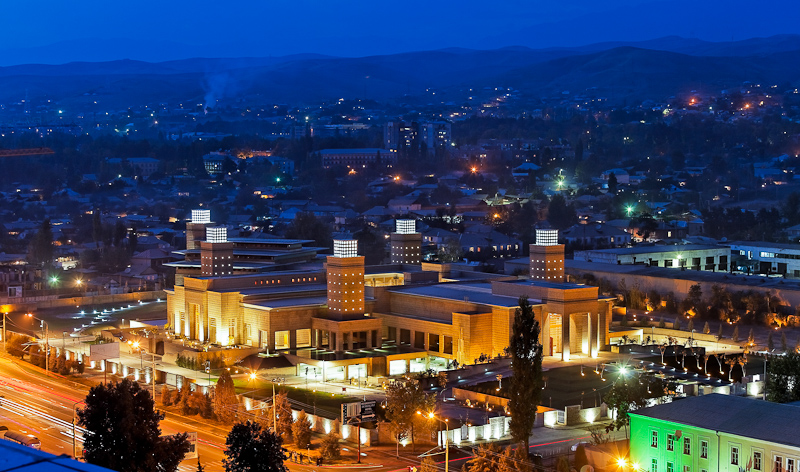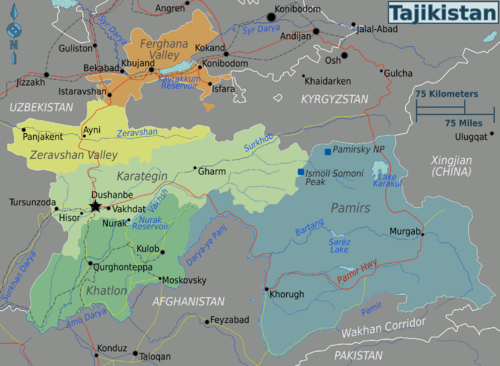First, the good news. Tajikistan has stunningly-beautiful mountain scenery and nature abounds. Next, 70% of the population is under 30, another good thing. More promising is the fact that the literacy rate is at 99%. Minerals found here include silver, gold, uranium and tungsten. Tajikistan also grows a lot of cotton. And by all accounts the people are friendly. Lastly, the Lonely Planet guidebook says this about Tajikistan:
Where ‘Great Game’ spies and explorers once ventured, Tajikistan’s awesomely dramatic highland landscapes are now testing playgrounds for hardy climbers, trekkers and adventure travellers. Nascent rural homestay programs mean you might stay in timelessly photogenic rural villages hosted by gold-toothed, white-bearded patriarchs in iridescent joma robes. (Lonely Planet, Tajikistan intro.)
Now for the rest. Tajikistan is rated as the poorest nation in central Asia. The country, a former Soviet republic, has been independent since 1991. A civil war which pitted the government against radical Islamists following independence has repercussions being felt even today. Thirty five percent of the population is classified as below the poverty line. Much like in the Philippines, many workers are forced to seek employment overseas and remit the money to support families. This remittance economy is said to make up as much as half of GDP.
Tajikistan has a Russian military base in its capital, Dushanbe, and has ongoing military relations with the US. It has also conducted anti-terror drills with China.
The country’s long-serving president, Emomali Rakhmon heads a secularist government that, according to an RFE report, is cracking down on religious extremism. On August 28, 2015 the Islamic Renaissance Party of Tajikistan was banned and told to dissolve.
Besides terrorism, Tajikistan is also plagued with corruption, economic mis-management and drugs; it is a major transit point for drugs from Afghanistan headed for Russia and the outside world. Limited local poppy cultivation is also reported.
While Lonely Planet paints a rather rosy picture of travel in exotic Tajikistan, the US State Department is a bit less upbeat:
Terrorist attacks involving suicide bombers have occurred in Tajikistan and in neighboring Uzbekistan. Minor explosions occasionally occur in Dushanbe…
Terrorists may target residential areas, clubs and restaurants, places of worship, hotels, outdoor recreation events, and other venues. The limited number of facilities catering to Westerners in Tajikistan presents a heightened risk. (US Dept. of State, Bureau of Consular Affairs, website)
And Canada adds:
Regional Advisory for areas bordering Afghanistan, the Kyrgyz Republic and Uzbekistan
Foreign Affairs, Trade and Development Canada advises against non-essential travel to the areas bordering Afghanistan, the Kyrgyz Republic and Uzbekistan because of security concerns. See Security for more information.
Regional Advisory for Gorno-Badakhshan
Foreign Affairs, Trade and Development Canada advises against all travel to Gorno-Badakhshan Autonomous Oblast (province), including to the city of Khorough, due to the unpredictable security situation. See Security for more information. (Govt. of Canada, website)
Finally, what does the future hold for the country? Probably much of the same. It does not seem that the country’s two big challenges, radical Islam and drugs, will disappear any time soon. Economically, however, there might be a chance for Tajik life to improve across the board. Some spinoffs from the modern, re-vitalized Silk Road might trickle down to Tajikistan, and warm relations with China may help to create some real prosperity. With security and prosperity, anything is possible.
Photos:
Top: FRDA
Map: Wikitravel
 日本語
日本語 English
English 中国語
中国語
